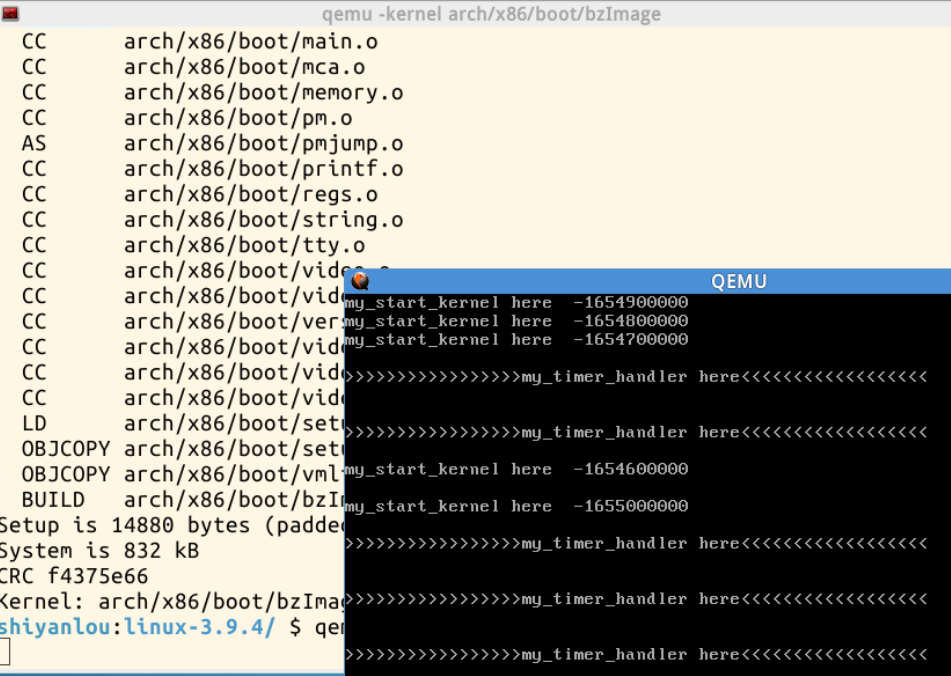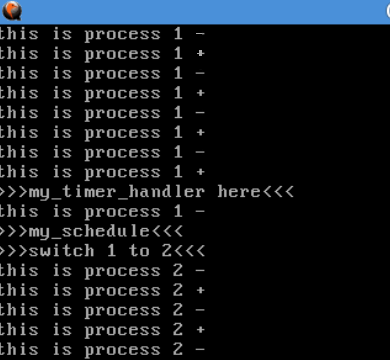学号: 363
原创作品,转载请注明出处。
本实验资源来源: https://github.com/mengning/linuxkernel/
一、 实验环境配置
本次实验在实验楼完成:
在实验楼的终端下输入下面命令:
cd LinuxKernel/linux-3.9.4 rm -rf mykernel patch -p1 < ../mykernel_for_linux3.9.4sc.patch make allnoconfig make
qemu -kernel arch/x86/boot/bzImage
可查看运行结果:

关闭qemu窗口,进入mykernel文件夹,可以查看mymain.c和myinterrupt.c文件。

mymain.c的代码不断循环的去执行,周期性的产生时钟中断信号,去执行myinterrupt.c的代码。
二、实现时间片轮转多道程序
将mymain.c,myinterrupt.c,mypcb.h三个文件复制替换到mykernel文件夹下。
运行如下:

可以看到进程1切换到了进程2。
三、时间片轮转多道程序的代码分析
mypcb.h
/* * linux/mykernel/mypcb.h * * Kernel internal PCB types * * Copyright (C) 2013 Mengning * */ #define MAX_TASK_NUM 4 #define KERNEL_STACK_SIZE 1024*2 # unsigned long /* CPU-specific state of this task */ struct Thread { unsigned long ip; unsigned long sp; }; typedef struct PCB{ int pid; volatile long state; /* -1 unrunnable, 0 runnable, >0 stopped */ unsigned long stack[KERNEL_STACK_SIZE]; /* CPU-specific state of this task */ struct Thread thread; unsigned long task_entry; struct PCB *next; }tPCB; void my_schedule(void);
可以看到最大进程数定义为四个,程序控制块PCB中定义了pid,状态statue,线程thread,进程入口函数task_entry等.
mymain.c文件
/* * linux/mykernel/mymain.c * * Kernel internal my_start_kernel * * Copyright (C) 2013 Mengning * */ #include <linux/types.h> #include <linux/string.h> #include <linux/ctype.h> #include <linux/tty.h> #include <linux/vmalloc.h> #include "mypcb.h" tPCB task[MAX_TASK_NUM]; tPCB * my_current_task = NULL; volatile int my_need_sched = 0; void my_process(void); void __init my_start_kernel(void) { int pid = 0; int i; /* Initialize process 0*/ task[pid].pid = pid; task[pid].state = 0;/* -1 unrunnable, 0 runnable, >0 stopped */ task[pid].task_entry = task[pid].thread.ip = (unsigned long)my_process; task[pid].thread.sp = (unsigned long)&task[pid].stack[KERNEL_STACK_SIZE-1]; task[pid].next = &task[pid]; /*fork more process */ for(i=1;i<MAX_TASK_NUM;i++) { memcpy(&task[i],&task[0],sizeof(tPCB)); task[i].pid = i; //*(&task[i].stack[KERNEL_STACK_SIZE-1] - 1) = (unsigned long)&task[i].stack[KERNEL_STACK_SIZE-1]; task[i].thread.sp = (unsigned long)(&task[i].stack[KERNEL_STACK_SIZE-1]); task[i].next = task[i-1].next; task[i-1].next = &task[i]; } /* start process 0 by task[0] */ pid = 0; my_current_task = &task[pid]; asm volatile( "movl %1,%%esp " /* set task[pid].thread.sp to esp */ "pushl %1 " /* push ebp */ "pushl %0 " /* push task[pid].thread.ip */ "ret " /* pop task[pid].thread.ip to eip */ : : "c" (task[pid].thread.ip),"d" (task[pid].thread.sp) /* input c or d mean %ecx/%edx*/ ); } int i = 0; void my_process(void) { while(1) { i++; if(i%10000000 == 0) { printk(KERN_NOTICE "this is process %d - ",my_current_task->pid); if(my_need_sched == 1) { my_need_sched = 0; my_schedule(); } printk(KERN_NOTICE "this is process %d + ",my_current_task->pid); } } }
在这个文件中void __init my_start_kernel(void)这个函数fork了4个新进程,把新fork的进程加入到进程链表在这个文件中。
汇编过程如下:
(1)将0号进程的esp的值赋给ESP寄存器
(2)将0号进程的esp的值压栈(此时堆栈状态为进程0的堆栈)
(3)将0号进程的eip的值压栈
(4)通过ret指令,让栈顶的eip的值出栈到EIP寄存器中(间接改变EIP寄存器的值),完成进程0的启动
myinterupt.c
/* * linux/mykernel/myinterrupt.c * * Kernel internal my_timer_handler * * Copyright (C) 2013 Mengning * */ #include <linux/types.h> #include <linux/string.h> #include <linux/ctype.h> #include <linux/tty.h> #include <linux/vmalloc.h> #include "mypcb.h" extern tPCB task[MAX_TASK_NUM]; extern tPCB * my_current_task; extern volatile int my_need_sched; volatile int time_count = 0; /* * Called by timer interrupt. * it runs in the name of current running process, * so it use kernel stack of current running process */ void my_timer_handler(void) { #if 1 if(time_count%1000 == 0 && my_need_sched != 1) { printk(KERN_NOTICE ">>>my_timer_handler here<<< "); my_need_sched = 1; } time_count ++ ; #endif return; } void my_schedule(void) { tPCB * next; tPCB * prev; if(my_current_task == NULL || my_current_task->next == NULL) { return; } printk(KERN_NOTICE ">>>my_schedule<<< "); /* schedule */ next = my_current_task->next; prev = my_current_task; if(next->state == 0)/* -1 unrunnable, 0 runnable, >0 stopped */ { my_current_task = next; printk(KERN_NOTICE ">>>switch %d to %d<<< ",prev->pid,next->pid); /* switch to next process */ asm volatile( "pushl %%ebp " /* save ebp */ "movl %%esp,%0 " /* save esp */ "movl %2,%%esp " /* restore esp */ "movl $1f,%1 " /* save eip */ "pushl %3 " "ret " /* restore eip */ "1: " /* next process start here */ "popl %%ebp " : "=m" (prev->thread.sp),"=m" (prev->thread.ip) : "m" (next->thread.sp),"m" (next->thread.ip) ); } return; }
通过my_time_handler()函数定时地不断向cpu发出中断,从而实现了时间片轮转。每调用1000次,就去将全局变量my_need_sched的值修改为1,通知正在执行的进程执行调度程序my_schedule。从而在my_schedule函数中完成进程的不断切换。
四、总结
(1)进程和中断在操作系统是是非常重要的两个部分,需要熟练掌握。
(2)EIP寄存器储存着当前执行的代码,可以通过更改EIP寄存器的值来更改当前执行的代码,从而实现进程切换。出于安全考虑,EIP寄存器的值不能被直接改变,但可以通过压栈+ret指令来间接改变。
(3)进程在执行过程中,当时间片用完之后需要进程切换时,需要保存当前的执行上下文环境,下次被调度的时候,需要回复进程的上下文环境。